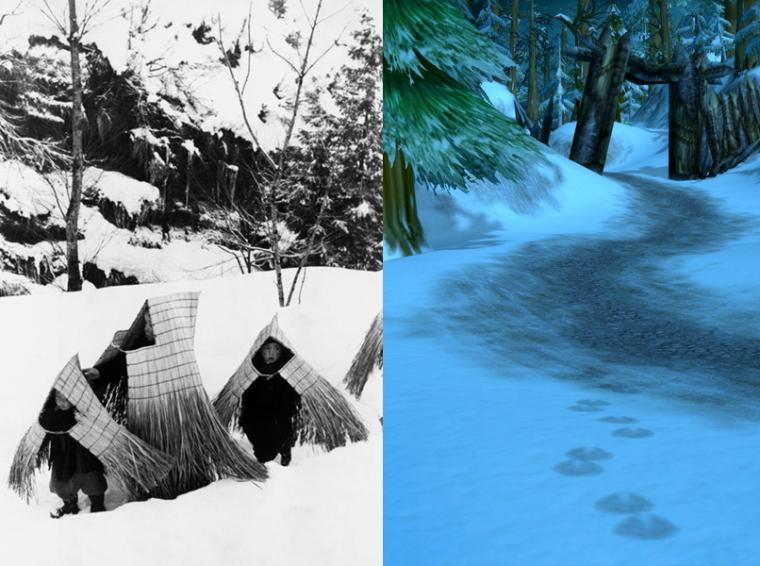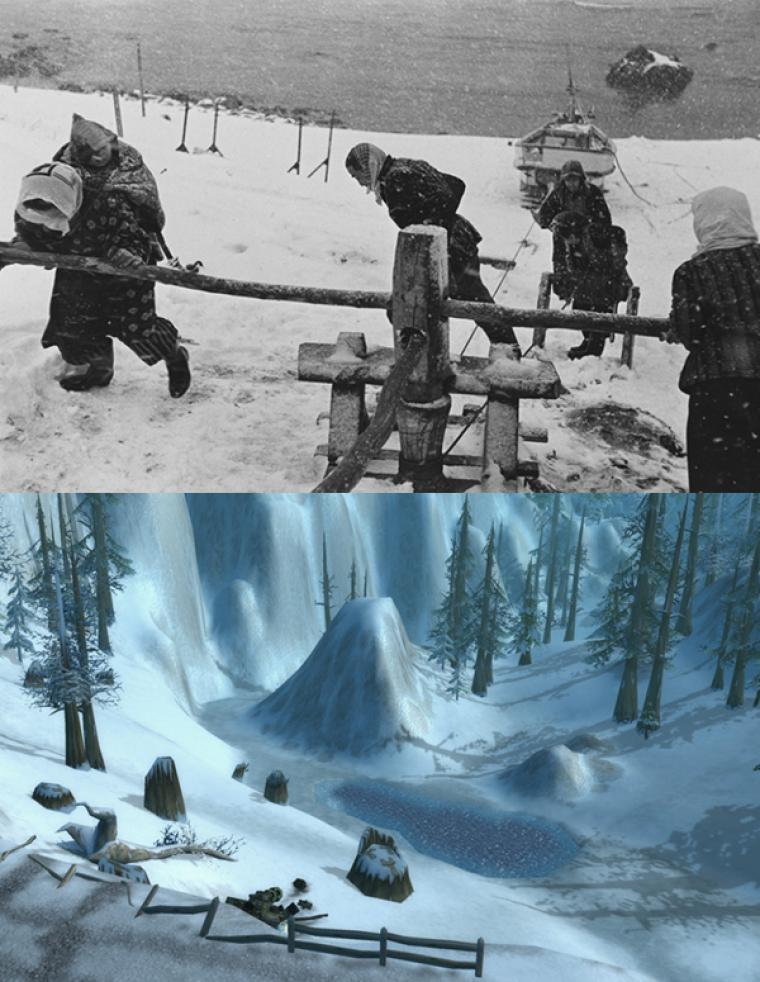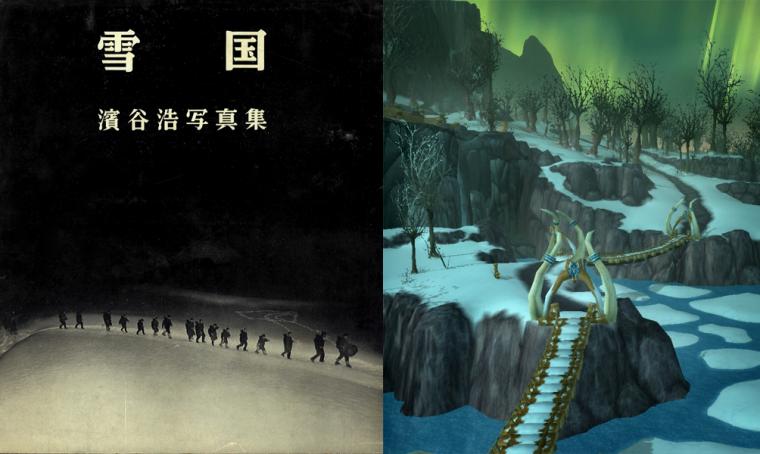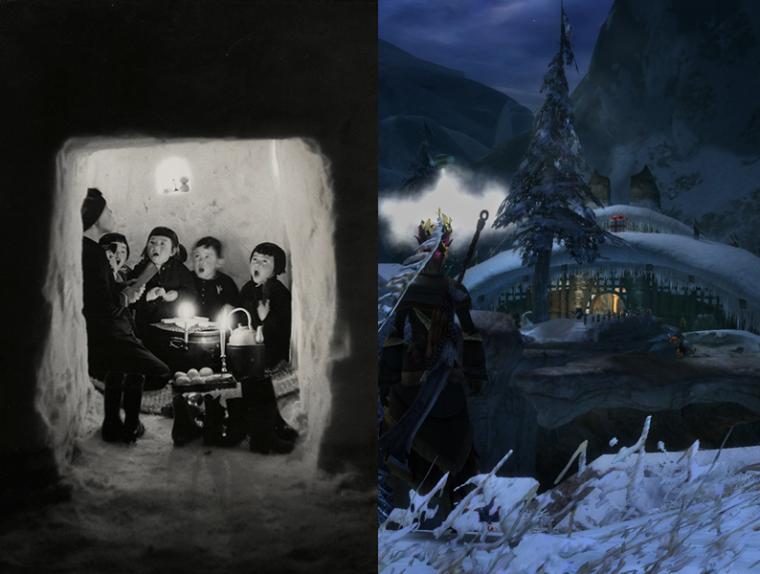Bridging Worlds: Snow Land

"Bridging Worlds" is a series by LA-based artist and VGT guest author Eron Rauch about the blurred line between games and art. These articles are intended as conversation starters about the burgeoning intersection between the fine art world, academic studies of games, virtual photography, and video game creation.
One of my favorite things to do during the winter months is to play MMOs. Specifically, with Los Angeles's lack of winter weather, I deeply enjoy playing through the inevitable snow regions. Yes, these regions are snowy year round (wouldn't getting a full seasonal cycle in an MMO be brilliant?) but there is something magical about wandering the majestic, pastel-lit slopes and snowdrifts at night with a glass of bourbon and eggnog in my hand. Often I find on these nights that I'm just wandering for wandering's sake, filling out map completion, poking into every moon-shimmering ice cave.
There are various nostalgic and social reasons that I enjoy these spaces: It probably has something to do with fantasy literature's love of seasons as metaphors. But more than that, I did grow up in areas with quite serious winters (both Chicago and Minnesota); winters that defined the kind of activities that you could do and gave life a certain rhythm.

Early on in winter it's bright and clear; tantalizing you to take a mid-day hike through the woods with sunglasses and scarfs as a necessity. The world gets darker over the next few weeks and then it's dumped a foot of snow and you're saddled in a parka and heavy boots shoveling driveways and walkways so you can get out of the house and to your stack of firewood. Intensifying over the next month, it reaches negative forty with wind chill and if you're outside for more than 15 minutes you're risking frostbite. So you catch up on your reading, huddled under a couple blankets and hoping that you've been to a grocery store lately so you don't run out of brandy. As spring is winking in the distance, your celebratory evergreen tree (a symbol of life) has turned brown and, so that your house doesn't catch on fire, you lug it out to the slushy gray street, the crusty, pale salt ruining clothing and rusting out the passing cars.
In real life, extremity of seasons or climates tends to inherently produce cultural and social forms.
What I'm getting at is that in real life extremity of seasons or climates tends to inherently produce cultural and social forms. What I don't love in these MMOs snow realms is that there are little to no functional or cultural changes required to explore these inclement zones. The cold doesn't mean you fumble with your frigid fingers; you can still wear your chain mail loin cloth; you can still meander around every hill and dale without the worry that you're going to sink up to you neck in a drift if you walk off a path; the animals aren't hibernating; inhabitants (NPCs) still mostly behave the same way that people in the next zone over do: getting you to help find someone who is lost (in the non-snow), asking for you to collect snow-berries, killing a few re-skinned pale creatures. It's just that everyone and everything has old Norse names instead of Saxon nomenclature.

In some areas a bit more North of where I lived in the Mid-West, the winter was even more defining; with roofs that need to be shoveled off from six feet of snow lest they collapse, wood that has to be chopped throughout the Fall and stacked in precarious piles a dozen feet high to heat the house since no one can get out to deliver fuel oil; and cars get traded for snow mobiles as they are the only way to get around. This is winter in a wealthy nation in 2013. Can you imagine a winter 400 years ago in the age of knights and drafty castles? I ask that question honestly because its answer, which relies on the scope of our (and the designers') travels and imagination, actually defines what can be created to experience in games.
Can you imagine a winter 400 years ago in the age of knights and drafty castles?
Partially why I've been thinking about this so much is that alongside my mulled-wine-winter-MMO-playing, I've been obsessing over a Japanese photo book from 1960's called Yukiguni, or Snow Land in English, by Hiroshi Hamaya. It is a series of images that are the result of a decade-long exploration of an area colloquially called the back coast (the area on the Western edge along the Sea of Japan) which most people in Japan at the time, let alone foreigners, knew next to nothing about. Here snow, traditional community, and hard work are the all-defining traits.

What is amazing to me is the way that the photographs and the overall layout so carefully use form to attempt to render the emotional feeling of this unique cultural, historical, and environmental space. Take a look at the cover of the original printing of the book. On-camera flash is used to illuminate the small foreground of a group of villagers walking in the night, a huge expanse of cold night filling the rest of the upper two-thirds of the cover. I have never seen an image that expresses the complexities of winter more eloquently; both the cold, dark nights and the way those nights draw people together.
In Hamaya's work there is also a celebration of the specifics, whether it be the high-collared woven-reed capes that allow the snow to slide off or the winter rituals where the children switch places with the adults for an evening, singing and hosting child-sized dinners in hollowed out snow huts. He also focuses on the labor, such as large-scale community ice fishing where groups men cut holes in the ice and strap nets around their waists, required to sustain this life at the edges of the habitable world. (There is another book which is worth reading in conjunction with the photos of Snow Land, titled similarly in English as Snow Country. Much darker and sadder, it is a novel by Yasunari Kawabata which explores the psychological tensions that occur in such small and oft-isolated communities in the back coast of Japan.)

The snow-lands, deserts, jungles, swamps and mountains — all of these areas common to fantasy video games require intensive knowledge and preparation (as well as the trust and respect of the locals) to visit in real life. All of the inhabitants of these areas develop specific rituals, traditions, communities and actions in conjunction with the environment to survive and thrive there. Whether it be discovered from a book like Snow Land or through bittersweet travel, video game worlds can be enriched, both visually and play-wise if your characters are allowed to struggle through the winter, not just inhabit a re-skinned balmy, citrus-tree-filled, 75 degree Los Angeles "winter."
Honoring the very real differences and challenges inhabiting environments both increases the engagement of the player and allows for more possibilities for the game designers to craft varied, deep worlds that go above and beyond the current predilection of merely making superficial aesthetic indicators of the snow realms.
(All photos by Hiroshi Hamaya. Video game screenshots by author. #1 & #2 from World Of Warcraft; #3 From WoW: Wrath Of the Lich King; #4 from Guild Wars 2).
